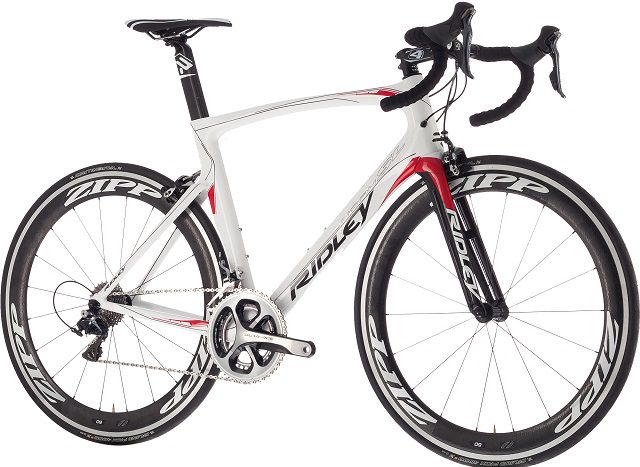Ridley Noah SL 20: Real-world performance, whether that involves the Tour de France or simply a tour of coffee stops
You may not always be the best judge of what bike is best for you. Let me explain what I mean. I’ve always identified with the climbers.

Ridley Noah SL 20
Components: Shimano Dura-Ace mechanical
Wheels: Zipp 60
Sizes: S, M, L
Price: $7,250
Website: mec.ca
You may not always be the best judge of what bike is best for you. Let me explain what I mean. I’ve always identified with the climbers. I thoroughly enjoy the rides that head up and up and up. As a result, I tend to gravitate toward lighter, sprightly machines. But where do I do most of my riding? I seek out the lumpiest parts in my predominantly flat part of the country. When I rode the Ridley Noah SL on my favourite loops, I felt like I was swooping through the terrain I was familiar with. It seems I live in aero country where tubes designed to manage wind instead of gravity are just the thing. The Noah SL was built for speed. After all, fast is in its lineage. According to Richard Wittenberg, Ridley’s vice-president of international operations, development of the Noah SL started in earnest about two years ago. He figures, however, that the Belgian company’s CeO and longtime frame builder Jochim Aerts probably had the idea for the Noah SL in his head even as he began development of Noah Fast, Ridley’s top-of-the-line aero machine, in 2009. After the Noah Fast came the Dean Fast, the time trial bike.
“When you look at the F-Surface and the tubing of the Noah SL, you’ll see 90 per cent of the aerodynamics of that frame are taken directly out of the TT bike,” Wittenberg said. The F-Surface he mentioned is a coating that is applied to specific areas of each of those bikes. It makes air adhere to frame better than a regular painted surface, reducing drag by 4.1 per cent, according to Ridley. The three frames also have the F-Splitfork, which features channels in each fork blade that move air away from the front wheel’s spokes. The company says the channels counter turbulence created by the wheel and reduce drag by 8.2 per cent. The aero feature that the Noah SL doesn’t share with its two predecessors is the F-Brake, brakes integrated into the front fork and, in the case of the Noah Fast, the seatstays.
The absence of the F-Brake speaks to the main goal of the Noah SL: take top-end features and make them accessible for everyday riders. To get the most out of the F-Brake, you need to be a pretty savvy mechanic, or have easy access to one. It’s also a more expensive technology. The Noah SL 20 I tested came with Dura-Ace caliper brakes. I’m quite familiar with their setup and maintenance, as well as their excellent performance. They’re well worth any aero penalty.
“The bike gave me the confidence to take corners – especially a certain hard right that comes at the bottom of a short, sharp descent – with a healthy amount of speed.”
Generally, when a bike maker focuses on getting the frame’s tubes as aero as possible, compliance, and thus comfort, takes a hit. Compliance in the Noah SL’s frame got a little more attention than those of the Fast or Dean. “We’ve made a nod to comfort, but we haven’t given it a full handshake,” joked Wittenberg. He noted that more compliance was engineered into the Noah SL’s seatstays, and that the standard seatpost takes the edge off of road vibrations a bit better than the Fast’s integrated seatpost. The Noah SL frame does offer a smoother ride through its ability to accommodate wider tires. While the Fast could only run some 25c treads depending on the brands, the Noah SL has no problem with that increasingly more common tire width. I rode a pair of 25c Continental Grand Prix 4000 S tires. The whole system felt fine on long rides over some less-thanideal roads, which makes Wittenberg’s “nod” seem more like an understatement.
Those tires sit on a pair of Zipp 60 wheels. They are a great match with the accessible-aero motif of the Noah SL. The hoops have a rim depth of 58 mm and have Zipp’s Aerodynamic Boundary Layer Control, a textured surface for grabbing the air. These wheels also have an aluminum brake track and tire bed. Sure they weigh about 200 g more than a pair of the latest all-carbon fibre 404s (1,820 g instead of 1,620 g), but with the 60s you can run stock brake pads and get great stopping power. The frame and fork hold those wheels well. The bike gave me the confidence to take corners – especially a certain hard right that comes at the bottom of a short, sharp descent – with a healthy amount of speed.
“With all of our bikes, we try to be fairly pragmatic with our design,” Wittenberg said. “You probably don’t have a mechanic who is dedicated to keeping your bike running. It’s going to be you, so the bike better be durable. It better be durable and stay that way.” While I might not have ridden the Noah SL as a hard as André Greipel did in this year’s Tour, it performed well ride after ride. It’s definitely a no-fuss, highperformance, ready-to-go machine. And speaking of the Tour, I hear Tony Gallopin used the Noah SL in the Pyrenean stages. As you can imagine, that’s something I can identify with.

